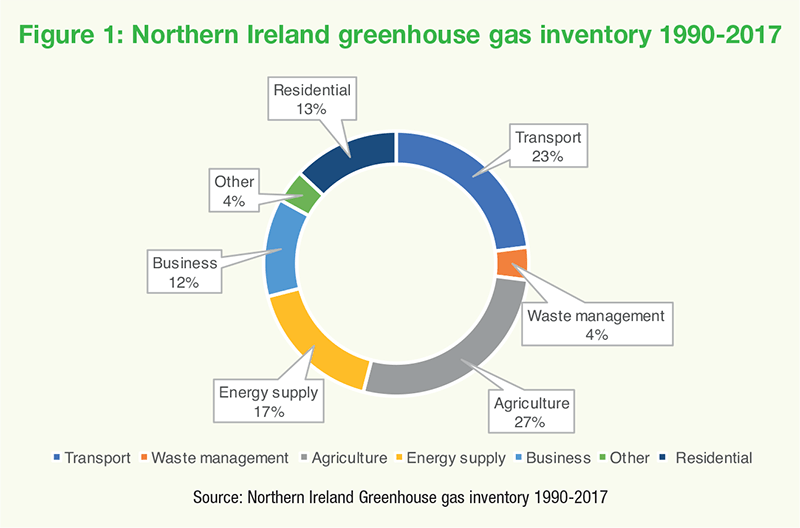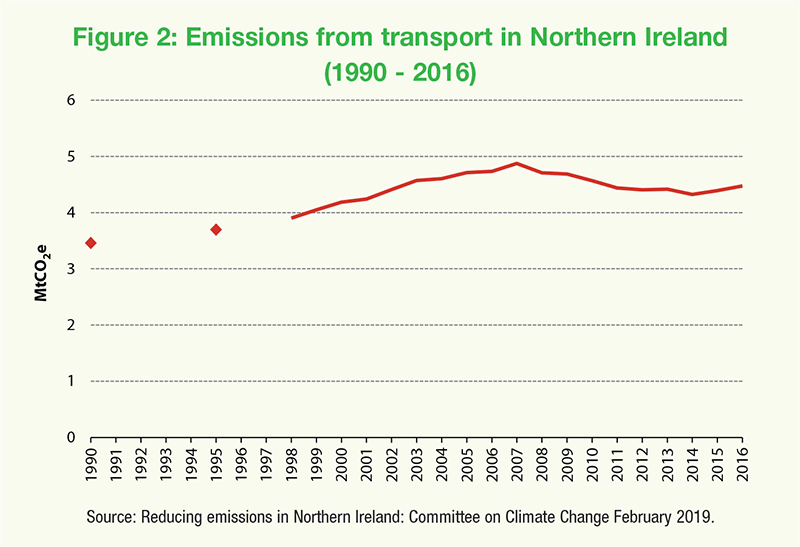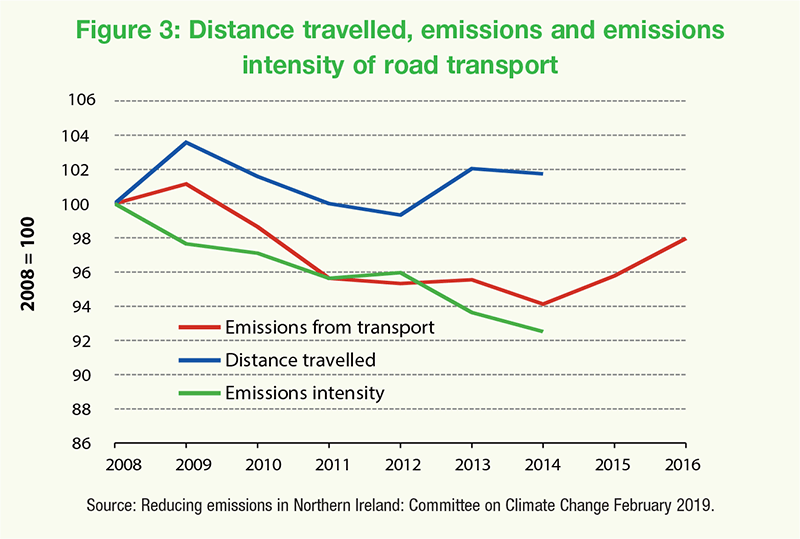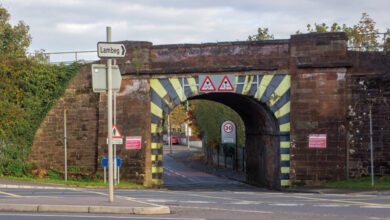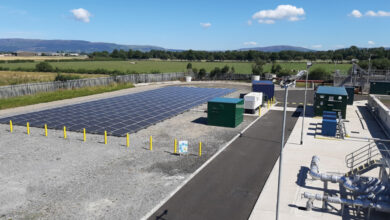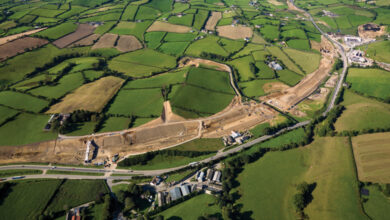Transport emissions: Northern Ireland
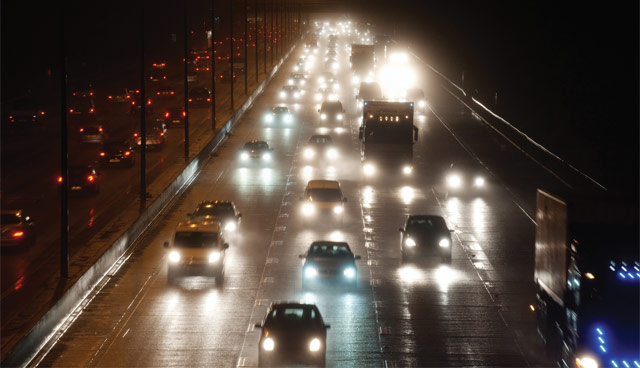
As a contributor to the UK’s overall greenhouse gas emissions target, the absence of climate change legislation for Northern Ireland has been identified as a factor in the likelihood that the UK could miss its targets for 2023-27. agendaNi assesses the contribution of transport targets on Northern Ireland’s emissions and outlines some potential changes to reduce these.
The UK has set out an ambitions target to reduce carbon emissions by at least 80 per cent from 1990 levels. Through its carbon budgets, the UK is on track to meet its targets out to 2022, however, there are concerns over whether ambitions for 2023-27 will be met.
In Northern Ireland, the absence of climate change legislation has meant that Northern Ireland continues to be loosely guided by UK policy. However, the unique economic and geographic make up of Northern Ireland means that such an approach has not led to significant progress in reducing carbon emissions in Northern Ireland, particularly in the largest contributing sectors such as agriculture and transport.
Latest figures by the Department of Agriculture, Environment and Rural Affairs (DEARA) show that in 2017, Northern Ireland’s greenhouse gas emissions were estimated to be 20 million tonnes of carbon dioxide equivalent, a decrease of 3 per cent compared to the previous year.
Northern Ireland accounts for around 4 per cent of the UK’s greenhouse gas emissions and while there have been significant decreases in some areas, others such as agriculture and transport appear to be on a trend of year-on-year increase.
The largest sectors in terms of emissions in 2017 were agriculture (27 per cent), transport (23 per cent) and energy supply (17 per cent). Energy efficiency in the form of the switching from coal to natural gas, and the introduction of methane capture and oxidation systems in landfill management, have driven large decreases in the energy supply, waste management and residential sectors.
However, transport emissions continue to increase and have experienced a 30.2 per cent emissions increase from the 1990 base year. This rise has been credited to the growth in demand for transport, despite improvements in efficiency of vehicles. Transport emissions grew 0.4 per cent from 2016 to 2017, however, while this figure marked a fourth year of consecutive increase, they mask an overall decrease of 5 per cent between 2008 and 2016.
The term transport includes road transport, domestic shipping and aviation, and aircraft support vehicles. Road transport is the most significant source of transport emissions and 70 per cent of all journeys in Northern Ireland were by car between 2015 to 2017, therefore emissions are affected by vehicle efficiency, distance travelled and number of vehicles.
However, attempts to establish the emissions impact of specific vehicle type has been made more difficult by the fact that road traffic data for Northern Ireland, expressed as vehicle-km travelled have not been recorded since 2014.
In 2018, the Committee on Climate Change was asked by DEARA to offer advice on how Northern Ireland could reduce greenhouse gas emissions between now and 2030. Within the report compiled by the committee, a recommendation is issued for the Government to resume collecting vehicle traffic data. Stating that such data is an “essential tool for planning decarbonisation strategies and monitoring progress in reducing emissions for road transport”.
The areas in which Northern Ireland could set about introducing policy to reduce emissions in road transport are limited to a certain degree. That fiscal levers are not devolved means that there is little scope to incentivise road tax breaks or lower emission vehicles outside of the UK’s approach. At the same time, vehicle standards are driven by EU legislation. Therefore, as the committee’s report suggests, policy directed at providing the necessary infrastructure to facilitate the greater use of electric vehicles, or to increase the use of public transport and active travel, would be more efficient.
Areas in which Northern Ireland can influence the uptake of electric vehicles through devolved policy are outlined as:
- operating and promoting specific schemes that have secured funding from the UK government;
- identifying and pursuing opportunities to secure funding from UK-wide funds for infrastructure in Northern Ireland;
- providing leadership by decarbonising the public sector and bus fleets;
- use of the infrastructure budget on electric vehicle charging infrastructure;
- setting targets for ULEV sales that go beyond those laid out in the UK’s Road to Zero Strategy; and
- taking steps to address non-financial barriers for electric vehicles, including local measures such as parking, use of priority lanes, and public awareness campaigns.
That Northern Ireland is lagging in its facilitation and encouragement of electric vehicle uptake can be seen in the fact that despite a 3 per cent rise from June 2017 to 2018 of charging points in Northern Ireland, the 470 charging points that are currently in operation are just 2.8 per cent of the overall UK number.
In 2016, the committee’s fifth carbon budget focussed on CO2 emissions from road transport as it made up 88 per cent of all emissions from transport in Northern Ireland, recognising that effective mitigation should prioritise this area. It estimates that a requirement for CO2 emissions from road transport to be 2.9 MtCO2 by 2030, meaning a 3.1 MtCO2 of abatement on the “business as usual baseline”.
Summarising the methods to bring this change about, the report suggests: “The main opportunities for reducing transport emissions through the 2020s are more efficient conventional vehicles, increased penetration of electric and plug-in hybrid vehicles and biofuels. Demand-side measures such as the promotion of ‘Smarter Choices’ including the use of public transport, eco-driving and developing cycling infrastructure, would add to abatement.”

